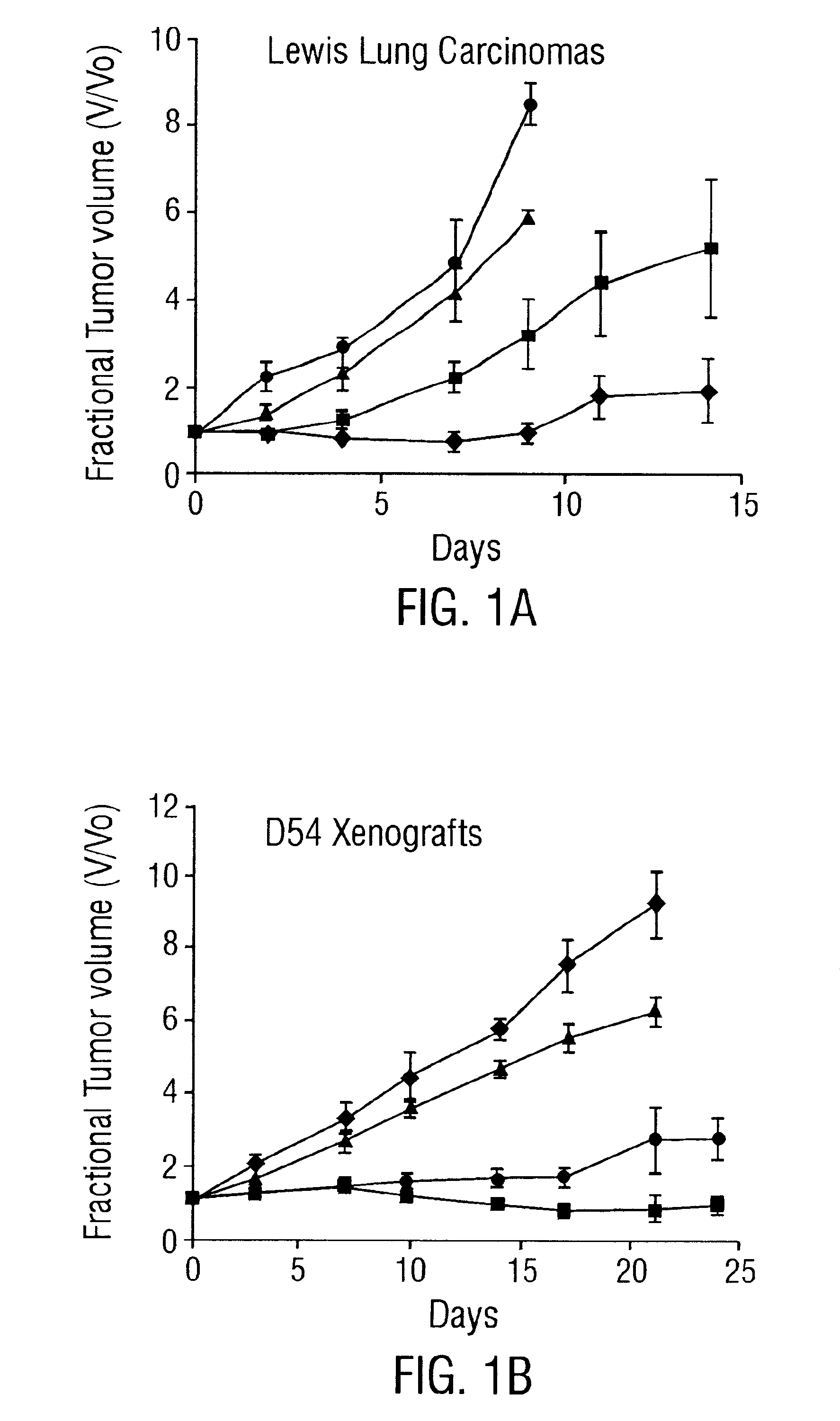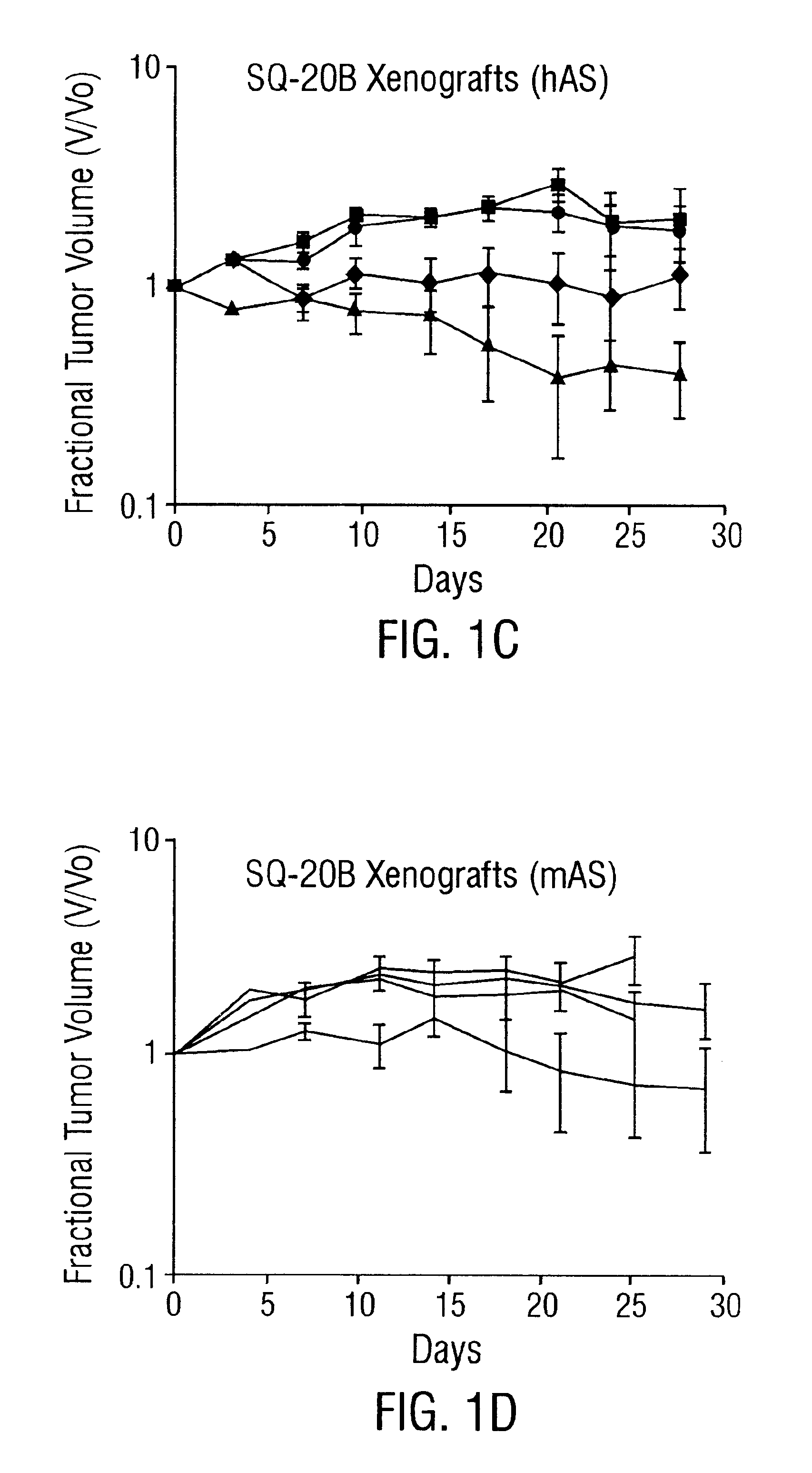Combination of radiotherapy and anti-angiogenic factors
- Summary
- Abstract
- Description
- Claims
- Application Information
AI Technical Summary
Benefits of technology
Problems solved by technology
Method used
Image
Examples
example 1
Methods
Cell culture. Lewis lung carcinoma cells (LLC-LM), a gift from Dr. Judah Folkman, were maintained in DMEM (Gibco, Grand Island, N.Y.) with 10% heat-inactivated fetal bovine serum (Intergen, Purchase, N.Y.) and penicillin / streptomycin (Gibco, Grand Island, N.Y.)). Human malignant glioma (D54) cell, a gift from Dr. Darell D. Bigher (Duke University Medical Center, Durham, N.C.), were cultured in 50% DMEM, 50% F-12 medium (Gibco, Grand Island, N.Y.), 7% fetal bovine serum and penicillin / streptomycin. SQ-20B squamous cell carcinoma cells, derived from a patient with recurrent squamous cell carcinoma of the larynx were maintained in DMEM: F-12 (3:1), 20% fetal bovine serum, 0.4 .mu.g / ml hydrocortisone (Sigma Chemical Co., St. Louis, Mo.) and penicillin / streptomycin. The SQ-20B cell line forms undifferentiated squamous cell cancer xenografts in nude mice and is relatively radioresistant (D.sub.0 =239 cGy), when compared with other tumor cell lines. PC3 prostate adenocarcinoma tumor...
example 2
Effects of Angiostatin and Ionizing Radiation on Primary Tumor Growth
To assess the effects of human angiostatin on primary tumor growth, the inventors treated mice bearing murine Lewis lung carcinoma tumors (LLC) with 25 mg / kg / day or 30 mg / kg / day. The dose of 25 mg / kg / day produced a 38% decrease in mean tumor volume and 50 mg / kg / day reduced mean tumor volume by 54% as compared with untreated controls (day 9; p=0.026). The inventors selected a dose of 25 mg / kg / day of human angiostatin for subsequent studies to permit optimal evaluation of a potential interaction between angiostatin and IR.
The effects of human angiostatin and ionizing radiation (IR) were examined in LLC tumors and in three human tumor xenograft models (D54, SQ-20B and PC3). These tumor endothelial cell lines, which differ in radiation sensitivities and growth kinetics, are derived from tumors in which local failure results in morbidity and mortality. The tumors volumes at the start of treatment ranged from 386 to 1104...
example 3
Effects of Angiostatin and Radiotherapy on Tumor Neovascularization
To evaluate the effects of treatment on tumor neovascularization, the representative tissue sections from LLC, D54 and SQ-20B tumors were examined using anti-CD31 antibody and standard immunohistochemical techniques. The number of vessels per high power field was reduced following exposure to combined treatment with human angiostatin and IR compared with all other treatments in LLC and D54 tumors. The number of vessels per high power field was also reduced in SQ-20B tumors exposed to combined treatment with angiostatin and IR compared with IR alone (p=0.04). Significant interactive treatment effects were observed in all tumor types [LLC (day 14, p=0.06), D54 (day 24, p=0.01) and SQ-20B (day 28, p=0.003); ANOVA].
PUM
| Property | Measurement | Unit |
|---|---|---|
| Time | aaaaa | aaaaa |
| Time | aaaaa | aaaaa |
| Time | aaaaa | aaaaa |
Abstract
Description
Claims
Application Information
 Login to View More
Login to View More - R&D
- Intellectual Property
- Life Sciences
- Materials
- Tech Scout
- Unparalleled Data Quality
- Higher Quality Content
- 60% Fewer Hallucinations
Browse by: Latest US Patents, China's latest patents, Technical Efficacy Thesaurus, Application Domain, Technology Topic, Popular Technical Reports.
© 2025 PatSnap. All rights reserved.Legal|Privacy policy|Modern Slavery Act Transparency Statement|Sitemap|About US| Contact US: help@patsnap.com



